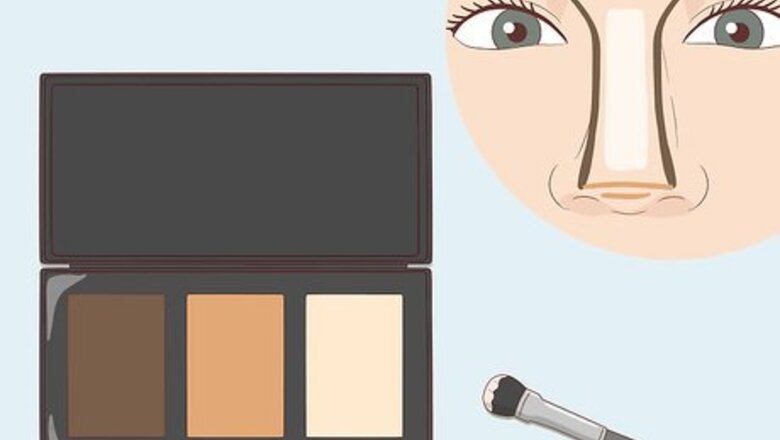
views
Here are 7 different ways you can straighten a crooked nose.
Contour it with makeup for a quick fix.
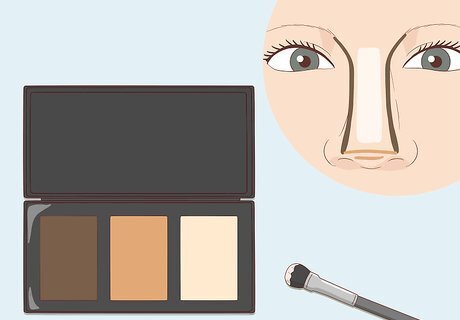
Get 1 highlighter, 1 bronzer, and 1 dark shade with gray undertones. Starting at your inner eyebrows and going down to the tip, draw 2 straight lines on each side of your nose with the gray shade. Make the lines perfectly straight. Then, use the bronzer to draw 2 straight lines right below the first ones you made (that way, when you blend the makeup, the darker colors will fade out and you won't have any harsh lines). Finally, make a super straight line down the center of your bridge with highlighter and use a big, fluffy brush to blend all of the lines together seamlessly. Use the same formula—liquid, cream, or powder—for all 3 contour shades. If you're using powder contour, apply it with a flat, angled brush. For cream or liquid contour, use your fingers, a sponge. For creamy stick formulas, you can apply it directly from the tube. The gray shade creates shadows to disguise the bent part of your nose. The bronzer softens those shadow lines so the contour looks more natural. The highlight creates the illusion of a super straight bridge.
Talk to a dermatologist or aesthetician about HA dermal fillers.
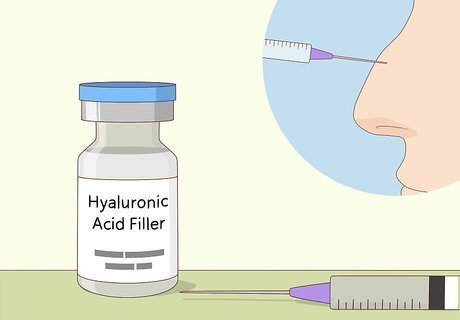
Filler injections require no down time and results last 6-12 months. Hyaluronic acid (HA) filler is strategically injected into your nose to create volume in hollow areas and refine the overall shape of the bridge and tip. The results are instant, although you may have mild swelling for 1-2 days. Don't let the word "acid" scare you—HA is a naturally-occurring sugar molecule already present in connective tissue. Your body slowly absorbs the filler, but you can repeat the procedure to maintain your results. See a cosmetic dermatologist or licensed aesthetician to find out if you’re a good candidate! Nose filler is often called “liquid rhinoplasty” or “nonsurgical rhinoplasty.” FDA-approved HA fillers for the nose include Juvéderm and Restylane. If you don't like the results, your doctor can dissolve the HA filler. Filler is charged by the syringe. Prices vary but $600 to $900 per syringe is a common price range. You'll probably need at least 2 syringes. HA is the preferred filler for nose reshaping. You've probably heard of Botox, but it's not filler. Botox injections paralyze muscles to smooth out wrinkles.
Ask a dermatologist about calcium-based dermal fillers.
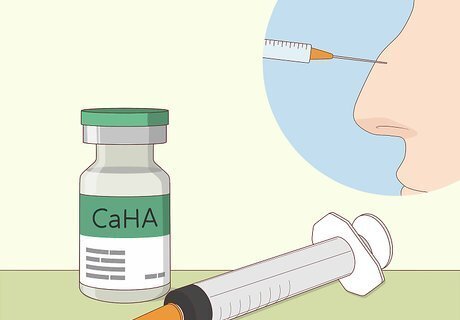
These fillers are safe and results can last up to 12 months. Calcium hydroxylapatite (CaHA) dermal injections are made of naturally-occurring material and can be used to correct nose asymmetry. CaHA filler lasts a little longer than HA filler and may stimulate your natural collagen production. However, using CaHA filler for nose reshaping is "off-label" (meaning it's not intended for nose reshaping). Cosmetic dermatologists and licensed aestheticians tend to prefer HA fillers for the nose, but it wouldn't hurt to ask about CaHA filler. After examining you, your doctor might decide that CaHA filler is the best choice to correct your nose. The only FDA-approved CaHA filler on the market is Radiesse. Unlike HA fillers, CaHA fillers aren't reversible. Unfortunately, if you don't like the results, you'll have to wait it out. CaHA fillers are usually used on rhinoplasty patients after their surgery to fix any lingering irregularities.
Look into surgical rhinoplasty for a permanent fix.
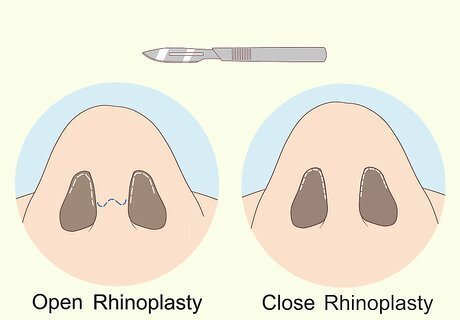
Talk to a licensed cosmetic surgeon to see if you’re a candidate. Rhinoplasty requires several weeks of down time and, like any surgery, carries some risks. The surgery is complex and highly individualized, so make an appointment with a licensed and experienced cosmetic surgeon to go over your options and come up with a surgical plan that’s right for you. There are 2 types of rhinoplasty: open and closed. Open rhinoplasty is more invasive and used to make fairly major adjustments. Closed rhinoplasty is less involved and works best for minor adjustments. Your surgeon will tell you what's best for your situation. Your doctor may inform you of limitations in the procedure or other elements that may play a role in the appearance of your nose. Rhinoplasty doesn’t require an overnight stay, so you’ll get to go home after being monitored for a few hours. The average cost for this surgery is $5,500, but it depends on the surgeon and the complexity of the surgery. Most insurances don’t cover cosmetic procedures, but it wouldn’t hurt to ask!
Ask about septoplasty if you have a deviated septum.
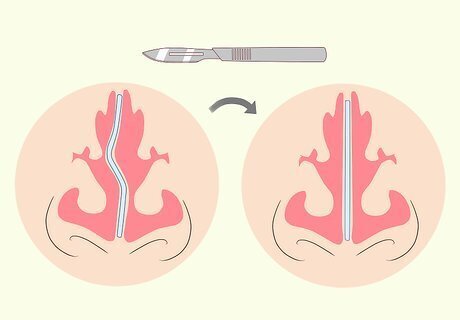
Septoplasty is a surgery to permanently straighten a deviated septum. Your septum is the wall of bone and cartilage between your 2 nostrils. If your septum tilts more toward 1 nostril than the other, you may have a deviated or "crooked" septum. Deviated septums usually make it harder to breathe and can cause snoring. During the procedure, a licensed surgeon cuts and removes parts of the septum and reinserts them in the proper place. You can have a septoplasty by itself or in conjunction with a rhinoplasty. Some health insurances may cover this particular surgery, so be sure to call your provider and ask about your options. The downtime after septoplasty is usually 3-4 weeks.
Skip facial exercises to fix a crooked nose.
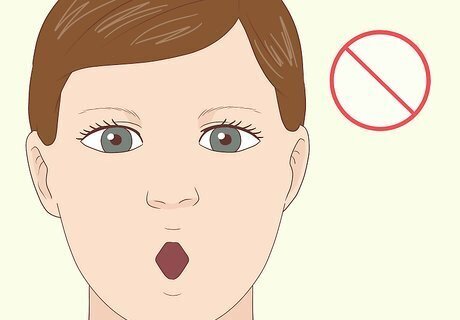
Facial exercises may help some issues, but not a crooked nose. You may have heard of facial exercises or "face yoga" and wondered if the exercises were worth a try to fix your crooked nose. Unfortunately, facial exercises can't help since your nose is mostly made of cartilage and bone.
Avoid at-home nose shaper devices.
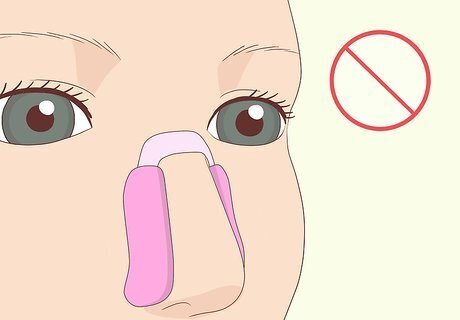
These devices aren't well-tested and may cause permanent damage. You've probably seen nose shaper devices online that claim to be able to fix a crooked nose. These devices usually attach to your nose in some way and attempt to force it into alignment, similar to the way splints are used for broken bones. These devices may seem tempting, but doctors don't recommend them. Nose shapers aren't well-tested or science-backed, and there's evidence that they can injure, bruise, or even permanently damage your nose.
















Comments
0 comment